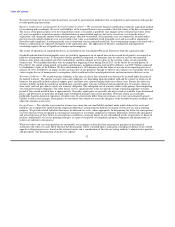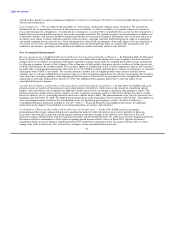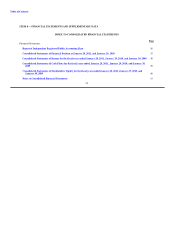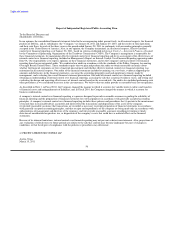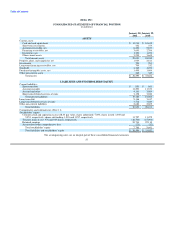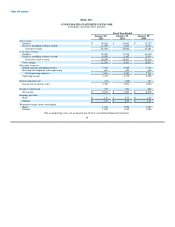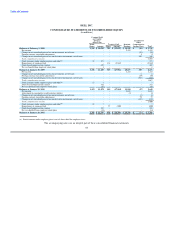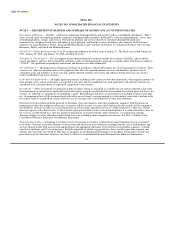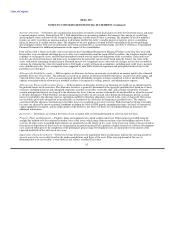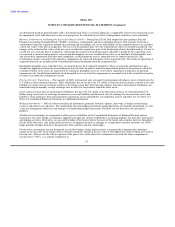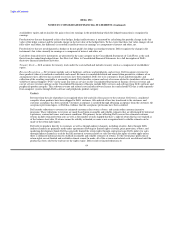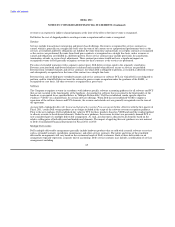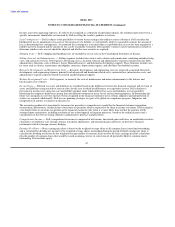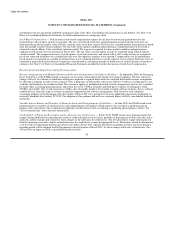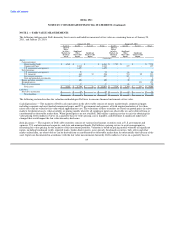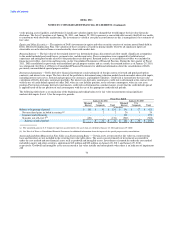Dell 2010 Annual Report Download - page 66
Download and view the complete annual report
Please find page 66 of the 2010 Dell annual report below. You can navigate through the pages in the report by either clicking on the pages listed below, or by using the keyword search tool below to find specific information within the annual report.
Table of Contents
DELL INC.
NOTES TO CONSOLIDATED FINANCIAL STATEMENTS (Continued)
Asset Securitization — Dell enters into securitization transactions to transfer certain financing receivables for fixed-term leases and loans
to special purpose entities. During Fiscal 2011, Dell adopted the new accounting guidance that removes the concept of a qualifying
special purpose entity and removes the exception from applying variable interest entity accounting. The adoption of the new guidance
requires an entity to perform an ongoing analysis to determine whether the entity's variable interest or interests give it a controlling
financial interest in a variable interest entity. The adoption of the new guidance resulted in Dell's consolidation of its two qualifying
special purpose entities with asset securitizations now being accounted for as secured borrowings. See Note 4 of Notes to Consolidated
Financial Statements for additional information on the impact of the consolidation.
Prior to Fiscal 2011, these receivables were removed from the Consolidated Statement of Financial Position at the time they were sold.
Receivables were considered sold when the receivables were transferred beyond the reach of Dell's creditors, the transferee had the right
to pledge or exchange the assets, and Dell had surrendered control over the rights and obligations of the receivables. Gains and losses
from the sale of fixed-term leases and loans were recognized in the period the sale occurred, based upon the relative fair value of the
assets sold and the remaining retained interest. Retained interest was recognized at fair value with any changes in fair value recorded in
earnings. In estimating the value of retained interest, Dell made a variety of financial assumptions, including pool credit losses, payment
rates, and discount rates. These assumptions were supported by both Dell's historical experience and anticipated trends relative to the
particular receivable pool.
Allowance for Doubtful Accounts — Dell recognizes an allowance for losses on accounts receivable in an amount equal to the estimated
probable losses net of recoveries. The allowance is based on an analysis of historical bad debt experience, current receivables aging, and
expected future write-offs, as well as an assessment of specific identifiable customer accounts considered at risk or uncollectible. The
expense associated with the allowance for doubtful accounts is recognized as selling, general, and administrative expense.
Allowance for Financing Receivables Losses — Dell recognizes an allowance for losses on financing receivables in an amount equal to
the probable losses net of recoveries. The allowance for losses is generally determined at the aggregate portfolio level based on a variety
of factors, including historical and anticipated experience, past due receivables, receivable type, and customer risk profile. Customer
account principal and interest are charged to the allowance for losses when an account is deemed to be uncollectible or when the account
is 180 days delinquent. While Dell does not place financing receivables on non-accrual status during the delinquency period, accrued
interest is included in the allowance for loss calculation and Dell is therefore adequately reserved in the event of charge off. Recoveries
on receivables previously charged off as uncollectible are recorded to the allowance for financing receivables losses. The expense
associated with the allowance for financing receivables losses is recognized as cost of net revenue. Both fixed and revolving receivable
loss rates are affected by macro-economic conditions including the level of GDP growth, unemployment rates, the level of commercial
capital equipment investment, and the credit quality of the borrower. See Note 4 of Notes to Consolidated Financial Statements for
additional information.
Inventories — Inventories are stated at the lower of cost or market with cost being determined on a first-in, first-out basis.
Property, Plant, and Equipment — Property, plant, and equipment are carried at depreciated cost. Depreciation is provided using the
straight-line method over the estimated economic lives of the assets, which range from ten to thirty years for buildings and two to five
years for all other assets. Leasehold improvements are amortized over the shorter of five years or the lease term. Gains or losses related to
retirements or disposition of fixed assets are recognized in the period incurred. Dell capitalizes eligible internal-use software development
costs incurred subsequent to the completion of the preliminary project stage. Development costs are amortized over the shorter of the
expected useful life of the software or five years.
Impairment of Long-Lived Assets — Dell reviews long-lived assets for impairment when circumstances indicate the carrying amount of
an asset may not be recoverable based on the undiscounted future cash flows of the asset. If the carrying amount of the asset is
determined not to be recoverable, a write-down to fair value is recorded. Fair values
62


